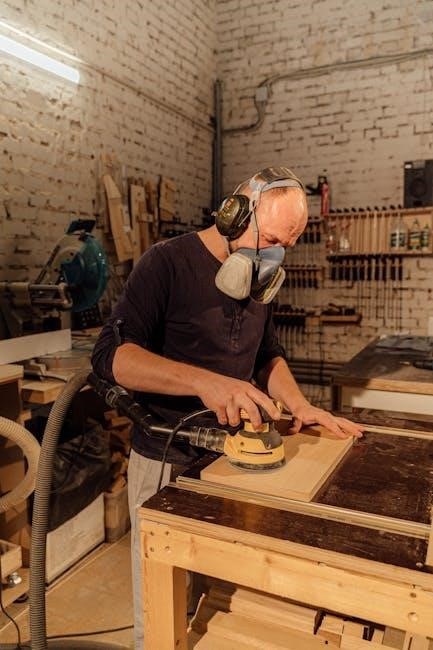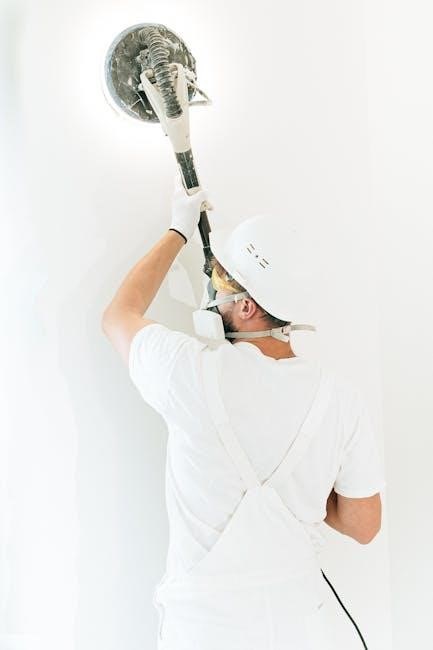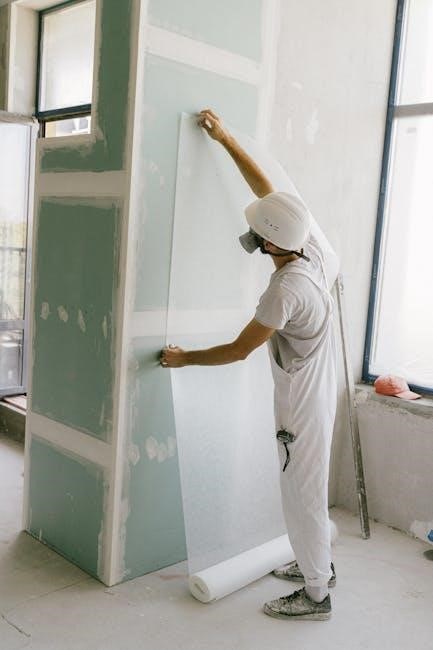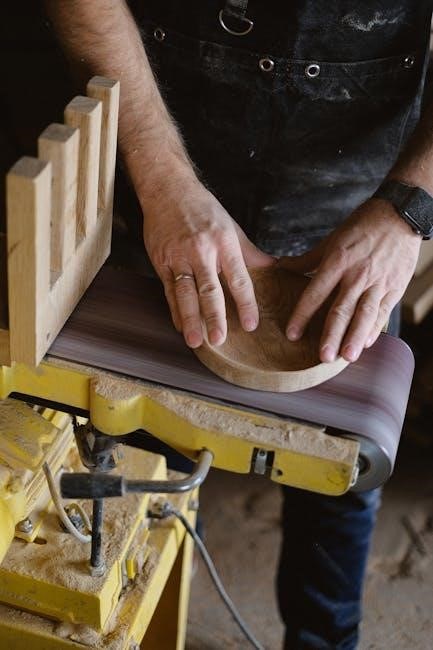Drywall Sander Manual: A Comprehensive Guide
This comprehensive guide offers essential information for safely and effectively using drywall sanders. Covering everything from basic operation to advanced techniques, it aims to assist both novice and experienced users in achieving professional-quality drywall finishing. Proper maintenance and troubleshooting are also addressed.
Drywall sanders are essential tools for achieving smooth, paint-ready surfaces on walls and ceilings. These tools expedite the sanding process compared to manual methods, saving time and effort. This manual provides a comprehensive overview of drywall sanders, encompassing various types, components, and safe operating procedures.
Whether you’re a professional contractor or a DIY enthusiast, understanding the nuances of drywall sanders is crucial for achieving optimal results. This section will delve into the basic principles of drywall sanding, highlighting the benefits and applications of these specialized tools. From removing imperfections to creating a flawless finish, drywall sanders play a pivotal role in any construction or renovation project.
Furthermore, this introduction will emphasize the importance of safety precautions and proper maintenance practices. By adhering to the guidelines outlined in this manual, users can ensure both their personal safety and the longevity of their drywall sander. This knowledge will empower you to confidently tackle drywall sanding tasks with efficiency and precision, resulting in professional-looking results every time.
Types of Drywall Sanders: Hand Sanders vs. Power Sanders
When it comes to drywall sanding, two primary categories of tools exist: hand sanders and power sanders. Hand sanders, often featuring a simple sanding block or pole sander design, are manually operated and ideal for smaller areas or detail work. They offer greater control and precision but require more physical effort.
Power sanders, on the other hand, utilize electric motors to automate the sanding process. These sanders come in various forms, including orbital sanders, rotary sanders, and specialized drywall sanders with extended handles and vacuum attachments. Power sanders are more efficient for larger surfaces and can significantly reduce sanding time.
Choosing between a hand sander and a power sander depends on the scope of the project, the desired level of control, and the user’s physical capabilities. This section will explore the advantages and disadvantages of each type, providing insights into selecting the most appropriate sander for specific drywall sanding tasks. Understanding these distinctions is crucial for achieving optimal results and maximizing efficiency.
Understanding the Components of a Drywall Sander
To effectively operate and maintain a drywall sander, whether manual or powered, a comprehensive understanding of its components is essential. A typical manual drywall sander consists of a sanding head, usually rectangular or round, designed to hold sandpaper securely. This head is often attached to a pole for extended reach, allowing users to sand walls and ceilings without excessive bending or stretching.
Powered drywall sanders have more complex parts. The sanding head, which can be orbital or rotary, is driven by an electric motor. Speed control allows adjustment of the sanding intensity. Many models feature a vacuum system, including a dust collection bag or hose attachment, to minimize airborne particles. The handle often incorporates ergonomic grips and switches for comfortable and convenient operation.
Understanding the function of each component – from the sandpaper attachment mechanism to the dust collection system – enables users to troubleshoot common issues, perform routine maintenance, and select appropriate accessories. This knowledge contributes to safer and more efficient drywall sanding, resulting in smoother finishes and reduced cleanup time. Familiarity with these parts is crucial for proper operation and longevity.
Safety Precautions Before Operating a Drywall Sander
Prioritizing safety is paramount before operating any drywall sander, whether manual or powered, to prevent injuries and ensure a safe working environment. Always wear appropriate personal protective equipment (PPE), including safety glasses or goggles to shield your eyes from dust particles, and a dust mask or respirator to prevent inhalation of fine drywall dust. Consider wearing ear protection, especially when using powered sanders, as they can generate significant noise.
Inspect the drywall sander for any signs of damage, such as frayed cords, loose connections, or malfunctioning switches. Ensure that the sandpaper is correctly attached and in good condition. If using a powered sander, verify that it is properly grounded and connected to a functioning electrical outlet. Keep the work area well-ventilated to minimize dust accumulation.
Before starting, clear the area of any obstructions or tripping hazards. Be aware of the location of power lines and other potential hazards. If working at height, use a stable ladder or scaffolding and maintain a secure footing. Never operate a drywall sander while under the influence of drugs or alcohol. By adhering to these safety precautions, you can significantly reduce the risk of accidents and injuries while sanding drywall.
Preparing the Work Area for Drywall Sanding

Effective preparation of the work area is crucial for efficient and safe drywall sanding. Start by removing all furniture, decorations, and other items from the room. Cover any remaining fixtures, such as light fixtures or windows, with plastic sheeting and painter’s tape to protect them from dust. Lay down drop cloths on the floor to collect dust and debris, making cleanup easier.
Ensure adequate ventilation by opening windows and doors or using a fan to circulate air. Consider using a dust collection system, such as a vacuum with a HEPA filter, to minimize airborne dust particles. Seal off doorways and other openings to prevent dust from spreading to other areas of the house. Check the lighting in the work area and add additional lamps or work lights if necessary to ensure good visibility.
Inspect the drywall surfaces for any protruding nails or screws and countersink them before sanding. Fill any large holes or imperfections with joint compound and allow it to dry completely. By taking the time to properly prepare the work area, you can reduce cleanup time, minimize dust exposure, and achieve a better sanding result. This preparation also contributes to a safer and more comfortable working environment.
Step-by-Step Guide to Using a Manual Drywall Sander
Using a manual drywall sander effectively requires a systematic approach. First, securely attach the appropriate grit sandpaper to the sanding head, ensuring it is properly aligned and firmly in place. Begin sanding with light, even pressure, using long, overlapping strokes. Avoid applying excessive pressure, as this can create uneven surfaces or damage the drywall paper.
Maintain a consistent sanding motion, moving the sander across the surface in a smooth, controlled manner. Pay close attention to seams, corners, and edges, as these areas often require more attention. Periodically check your work to assess the progress and identify any areas that need further sanding. Remove dust buildup from the sandpaper regularly using a brush or vacuum to maintain optimal sanding efficiency.
For larger areas, work in sections to ensure consistent results. Overlap each section slightly to blend the sanding seamlessly. If you encounter any stubborn imperfections, consider using a slightly coarser grit sandpaper to address them, but be careful not to over-sand. Once you have achieved the desired smoothness, wipe down the drywall surfaces with a damp cloth to remove any remaining dust. This step-by-step approach will help you achieve professional-looking results with your manual drywall sander.
Attaching Sandpaper to the Sander
Properly attaching sandpaper to your drywall sander is crucial for achieving a smooth, even finish. First, ensure the sander is unplugged or the power source is disconnected for safety. Clean the sanding pad surface to remove any dust or debris, as this can interfere with adhesion. Select the appropriate grit sandpaper for your project; coarser grits are for initial leveling, while finer grits are for smoothing.
Most drywall sanders utilize a hook-and-loop (Velcro) system for attaching sandpaper. Align the sandpaper disc with the sanding pad, ensuring it is centered; Press the sandpaper firmly onto the pad, making sure the hooks and loops engage completely. For sanders with clamp systems, loosen the clamps and insert the sandpaper edges under them, then tighten the clamps securely. Ensure the sandpaper is taut and wrinkle-free.
Before beginning sanding, double-check that the sandpaper is securely attached. A loose or improperly attached sandpaper disc can damage the sanding pad or create uneven sanding marks. Replace the sandpaper when it becomes worn or clogged with dust. This will maintain optimal sanding efficiency and prevent damage to the drywall surface. Regularly inspecting and replacing sandpaper is essential for achieving professional results.
Sanding Techniques for Smooth Finishes
Achieving a smooth finish on drywall requires mastering specific sanding techniques. Start with a coarse grit sandpaper (around 80-100) to level imperfections and remove excess joint compound. Apply light, even pressure, avoiding excessive force which can gouge the drywall. Use overlapping strokes in a circular or figure-eight motion to ensure consistent sanding across the surface.
After the initial leveling, switch to a medium grit sandpaper (around 120-150) to refine the surface. Continue using light pressure and overlapping strokes. Pay close attention to edges and corners, feathering them smoothly into the surrounding drywall. Regularly inspect your work with a bright light to identify any remaining imperfections or ridges.
For the final smoothing, use a fine grit sandpaper (around 220 or higher). This will remove any remaining scratches and create a paint-ready surface. Maintain light pressure and use long, sweeping strokes. Vacuum or wipe down the drywall surface between each grit change to remove dust and debris. This prevents coarser grit particles from scratching the finer finish. Remember, patience and consistent technique are key to achieving a flawless, smooth drywall finish.
Troubleshooting Common Issues with Manual Drywall Sanders

Manual drywall sanders, while simple, can still present challenges. One common issue is sandpaper slippage. Ensure the sandpaper is correctly attached to the sanding pad using the appropriate hook and loop system or clamping mechanism. If slippage persists, the sanding pad may be worn and require replacement. Another frequent problem is uneven sanding, often resulting from inconsistent pressure or technique.
Maintain a light, even pressure and use overlapping strokes to avoid creating dips or ridges. Check the sanding pad for debris buildup, as this can also contribute to unevenness. Scratches appearing on the surface indicate that the sandpaper grit is too coarse or that excessive pressure is being applied. Switch to a finer grit and reduce the pressure.
Difficulty reaching high areas can be overcome using extension poles designed for manual sanders; Ensure the pole is securely attached and adjusted to the appropriate length. Excessive dust accumulation is inevitable, but a dust mask is critical for safety. Regularly vacuuming the work area is recommended. If the sanding head becomes difficult to maneuver, inspect the swivel joint for obstructions or damage, cleaning or replacing if necessary. By addressing these common issues promptly, you can maintain optimal performance and achieve professional results with your manual drywall sander.
Maintenance and Care of Your Drywall Sander
Proper maintenance is crucial for extending the lifespan and ensuring the optimal performance of your drywall sander. After each use, thoroughly clean the sanding pad to remove accumulated dust and debris. Use a stiff brush or vacuum cleaner to prevent buildup, which can affect sanding effectiveness. Regularly inspect the sanding pad for wear and tear, replacing it when necessary to maintain a smooth, even sanding surface.
For manual sanders with swivel joints, apply a small amount of lubricant periodically to ensure smooth movement and prevent stiffness. Check the extension pole for any signs of damage, such as bends or cracks, and replace it if needed. Store your drywall sander in a clean, dry environment to prevent rust and corrosion. Avoid storing it in direct sunlight or extreme temperatures, which can damage the materials.
When not in use, consider storing the sander in a case or bag to protect it from dust and physical damage. If your sander uses a clamping mechanism for sandpaper attachment, inspect the clamps regularly and tighten them as needed. By following these simple maintenance tips, you can keep your drywall sander in top condition, ensuring reliable performance and consistent results for years to come. Remember to always consult your sander’s manual for specific maintenance recommendations.

Choosing the Right Sandpaper Grit for Your Project

Selecting the appropriate sandpaper grit is essential for achieving a smooth and professional drywall finish. The grit number indicates the size of the abrasive particles on the sandpaper; lower numbers represent coarser grits, while higher numbers signify finer grits. For initial drywall sanding, especially when dealing with imperfections or excess joint compound, start with a coarser grit such as 80 or 100. These grits effectively remove material and level the surface.
Once the surface is relatively even, switch to a medium grit sandpaper, typically around 120 or 150. This step helps to refine the surface and remove any scratches left by the coarser grit. For the final sanding stage, use a fine grit sandpaper, such as 180 or 220, to achieve a smooth, paint-ready finish. This fine grit will eliminate any remaining imperfections and create a consistent surface texture.
When sanding between coats of paint or primer, a very fine grit sandpaper, like 220 or 240, is recommended to lightly scuff the surface and promote adhesion. Always remember to clean the surface thoroughly between each sanding step to remove dust and debris. Choosing the right sandpaper grit for each stage of your project will ensure a flawless and professional-looking result. Experimenting on a small, inconspicuous area can help you determine the optimal grit for your specific drywall and joint compound.
Proper Storage of Drywall Sanders and Accessories
Proper storage is crucial for maintaining the longevity and performance of your drywall sander and its accessories. After each use, thoroughly clean your drywall sander to remove any accumulated dust and debris. Use a brush or vacuum cleaner to clean the sanding pad, motor housing, and any other accessible parts. Disconnect the power cord or remove the battery before cleaning to prevent accidental activation.
Store the sander in a dry, clean environment, away from extreme temperatures and humidity. Consider using a dedicated storage case or bag to protect the sander from physical damage and dust accumulation. Wrap the power cord neatly to prevent tangling and damage. Organize sanding discs by grit and store them in a container or organizer to prevent damage and make it easy to find the right grit for your next project.
For pole sanders, disassemble the pole into sections for easier storage and to prevent bending or damage. Store extension poles horizontally to avoid warping. Regularly inspect your drywall sander and accessories for any signs of wear and tear. Replace worn or damaged parts promptly to ensure safe and efficient operation. By following these storage guidelines, you can extend the life of your drywall sander and keep it in optimal condition for future use. A well-maintained sander will provide consistent performance and save you time and money in the long run.
Advanced Sanding Tips and Tricks
Once you’ve mastered the basics of drywall sanding, you can explore advanced techniques to achieve even smoother and more professional finishes. Consider using a dampened sponge to lightly wipe down the drywall surface after sanding. This helps to remove any remaining dust particles and reveals imperfections that may have been missed during sanding; Use a bright work light positioned at an angle to the wall to highlight imperfections such as ridges, bumps, or scratches.
When sanding corners, use a specialized corner sanding tool or a sanding sponge folded into a sharp edge. Apply gentle pressure and focus on maintaining a consistent angle to avoid rounding the corner. To blend patched areas seamlessly with the surrounding drywall, use a feathering technique. Gradually reduce the pressure as you move away from the patched area, creating a smooth transition. For large areas, consider using a power sander with a vacuum attachment to minimize dust and speed up the process.
Experiment with different sanding grits to find the optimal combination for your specific drywall compound and desired finish. Start with a coarser grit to remove imperfections and then gradually move to finer grits for a smoother surface. Always wear appropriate safety gear, including a dust mask, eye protection, and hearing protection, when using power sanders. By incorporating these advanced tips and tricks into your drywall sanding routine, you can achieve professional-quality results and create flawless walls and ceilings.

